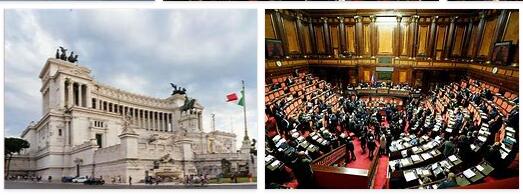As a country that belongs to European Union according to allcountrylist.com, Italy is bordered to the south by the seas of the Mediterranean Sea, Tyrrhenian, Ionian, to the south and east, and to the north by the Adriatic Sea, Slovenia and Austria and to the northwest by France, Switzerland and the Ligurian Sea, in the Mediterranean. Within the Italian peninsula there are also the independent countries of San Marino (City) and Vatican City.
Territorial expansion
From the northwest to the southeast of the country it is about 1,145 kilometers long; With the peninsula from north to south, Italy has a length of 1,360 kilometers. The greatest width from west to east is about 610 kilometers in the continental zone and 240 kms. on the peninsula.
Relief
More than half of the Italian territory is forming a peninsula that rises to the southeast of the Mediterranean Sea. To the north, the Cordillera de Los Alpes stands out, where are the Monte Cervino (4478 m) and Monte Rosa (4683 m). The highest peak in Italy is Monte Bianco, on the border between Italy and France, at about 4807 meters high. Between the Alps and the Apennines lies the Lombardy valley, bathed by the Po river. The coast of Italy that is on the Adriatic Sea is low and with a lot of sand. The west coast is characterized by having a number of bays and gulfs. In Sicily you will find Etna volcano.
Climate
The climate in Italy is varied, from a cold climate in the elevations of the Apennines and The Alps, to semi-tropical on the Ligurian coast. The average annual temperature increases ranges from 11 ° C to 19 ° C; around 13 ° C in the Po Valley, 18 ° C in Sicily and 14.5 ° C on the lower coasts. The climatic conditions in the peninsula are characterized by regional variations, the result of the differences between the mountain systems and the influence of the winds from the seas. In the lower regions winters They are mild and the temperatures are modified by the Mediterranean breezes. However, in high areas the temperatures are colder, even at the same latitudes. In contrast to semi-tropical conditions, near the Gulf of Genoa the climate is continental, with hot summers and severe winters and lots of rainfall.
Flora and fauna
The flora in the central and lower regions is typically Mediterranean. The characteristics of the vegetation is the existence of olive trees, some palms and citrus. Other common varieties, especially in the south, are fig, dates, pomegranate, sugar cane, almond trees and cotton. The vegetation near the Apennines resembles that of Central Europe. In Italy there are few varieties of animals, compared to other regions of Europe ; marmots can be found in small numbers, mountain goats. The bear, formerly in large numbers, is now near extinction, but wolves and wild boars can still be found in considerable numbers in mountainous regions. Another common animal is the fox. There are also varieties of predatory birds, eagles, vultures, buzzards and falcons, as well as various species of reptiles.
Hydrography
Italy does not have large hydrographic basins, due to the arrangement of its relief. The largest is that of the Po in the north, since it runs through the largest plain in the country. The Italian rivers are of the Mediterranean type, they have a very pronounced low water in August. Many of them go dry. In general, they are of pluvionival feeding, except for the rivers that have their head in the Alps, which are of nivopluvial feeding.
Main cities
The capital is Rome, which is also the largest city. Other major cities are Milan, Naples, Turin, Palermo, Genoa, Bologna, Florence, Bari, Catania, and Venice.
Economy
The country’s economy is highly industrialized, it has been the great driver of its development and the basis of its solidity, they also have great income from tourism.
Currency
The current Italian currency unit is the Euro.
Natural resources
Italy has few natural resources, the soil and climatic conditions are adverse for a good development of agriculture. It has very few mineral resources although there are some deposits of natural gas, oil, lignite, sulfur and pyrite ; other deposits include zinc, mercury, manganese, and bauxite. Many of these are found on the islands of Sicily and Sardinia. However, Italy is rich in various types of stone for construction, it has marbles of high quality and fish of high commercial value in territorial waters.
Government
From 2 as June as 1946, when the monarchy was abolished by popular referendum, Italy has declared a democratic republic. The current constitution was approved on January 1, 1948. The reestablishment of the fascist party is prohibited, and nobility titles are no longer recognized, although those acquired before October 28, 1922 can be used as part of the name.
Gastronomy
The Italian cuisine is very famous for its pastas, pizzas and risotto, their cuisines reflect the cultural variety of its regions as well as the diversity of its history, it is a kitchen where abundant aromas and flavors of the Mediterranean world. Italian cuisine is included within the so-called Mediterranean gastronomies and is imitated, as well as practiced all over the world.
Parties
| Festivities Date | Name in Spanish | Local name |
| April 25th | Liberation Anniversary | Liberation |
| June 2nd | Feast of the republic | Festa della Repubblica |
| August 15th | Assumption of Mary | Assunta (Ferragosto) |
| December 8 | Immaculate Conception | Immacolata Concezione |
| December 25th | Christmas | Natale |
| December 26 | St. Stephen’s Day | Santo Stefano |
